By Pixelle Specialty Solutions
Abstract
Today, more and more label printers are faced with this question from their brand-owner customers. Paper labels are produced customarily using coated one-side (C1S) label paper, yet questions often arise when coated two-side (C2S) papers are explored as a label-paper alternative. This may be due to a number of reasons, including availability, pricing or simply questioning the status quo. There are differences between C1S and C2S papers, and these differences can significantly impact the processing and performance of labels in their end-use.
Design and functionality of adhesive side of C1S labels
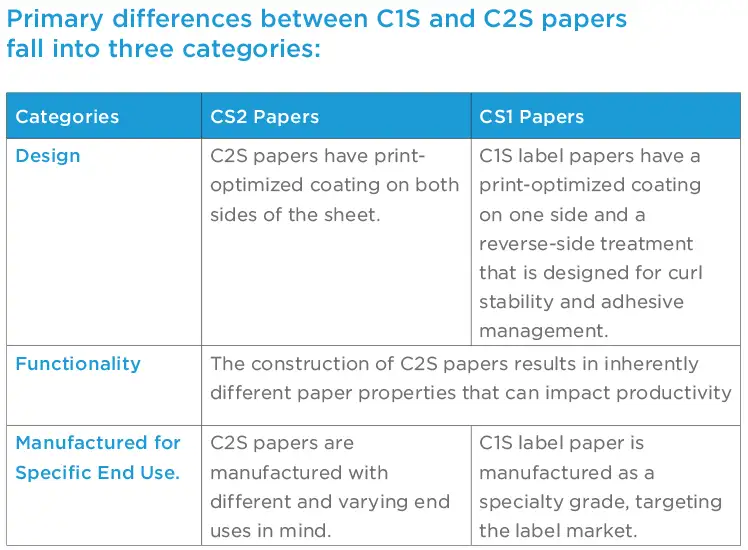
For this discussion, C1S labels are defined as labels that are printed typically in sheet form, cut to size and applied to containers with an automated labeler using wet glue or hot-melt adhesives. C1S labels often are referred to as cut-and-stack labels and have become a major labeling format for many food and beverage products sold today. C2S papers are primarily used for commercial printing of materials such as brochures, magazines and promotional pieces (see Table 1).
Water resistance is a critical attribute of label paper performance. Proper water resistance ensures predictable and controlled penetration of adhesives. It often is assumed that the glossy reverse side of a C2S paper provides adequate “holdout” to control the penetration of adhesives, but this is not always
the case.
To understand why this is important, we have to look at why label papers need predictable and controlled adhesive penetration on the non-printed side. In most labeling applications, adhesive is applied to the reverse-side of the label, and then the label is transferred to a container that is typically non-permeable, such as a can, jar or bottle. In the time between the adhesive application and when the label is applied, the label needs to behave in a predictable manner and absorb a limited amount of adhesive to build tack and develop a bond with the label, but not so much absorption that it dries the adhesive and reduces its tack.
Three primary issues can result from the label not properly managing the adhesive:
- Glue may be absorbed into the label too quickly, and the glue will not be available to adhere the label to the container, leading to flagging (when the edge of a label lifts off the surface after application).
- With nothing to limit migration of liquid through the label, the adhesive penetrates, creating staining or cockling (wrinkled, puckered or curled appearance) on the printed side. In extreme cases, it may soften the print-side coating and make labels more prone to scuffing or ink rub-off.
- If the label does not absorb adhesive quickly enough, then “swimming” can occur, where labels slide due to the adhesive’s inability to build enough tack to hold the label firmly in place.
Adhesive holdout
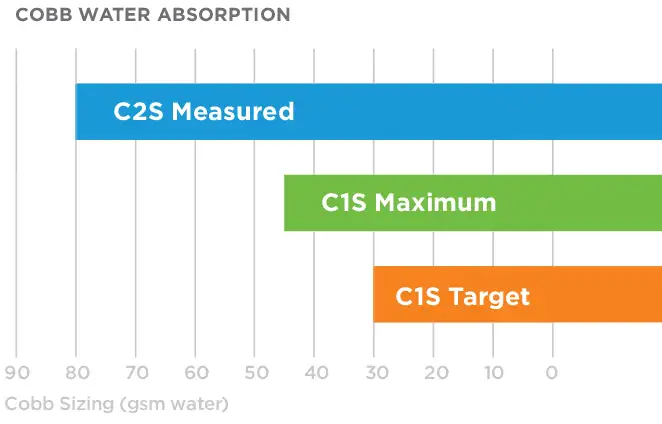
Now that we have established the need to limit absorbance of liquids other than inks into the label, we can look at the relative “holdout” provided by the print-optimized coating of C2S paper and the reverse-side coating of a C1S label paper. To do this, we examine two common measurements – cobb sizing and contact angle.
Cobb sizing: The cobb-sizing test measures how much water can be absorbed by the reverse side of the label. When this test is performed on both products, the glossy coated side of C2S paper allows twice as much water to be absorbed into the label than the reverse side of a C1S label (see Figure 1). The difference is not all due to coating – in fact, most of the difference is due to different fiber treatments in C1S versus C2S papers – but it demonstrates that the glossy coating of C2S paper does not provide much benefit with regard to controlling penetration of water-based liquids.
Contact angle: Contact angle also can be measured on the surface exposed to the adhesive to tell more about how the coating surface interacts with adhesive. Figure 2 shows that the reverse side of C1S label paper is less prone to absorbing liquid, while the glossy coating on C2S paper actually is more “spongelike” in its absorption of liquid as soon as it hits the surface.
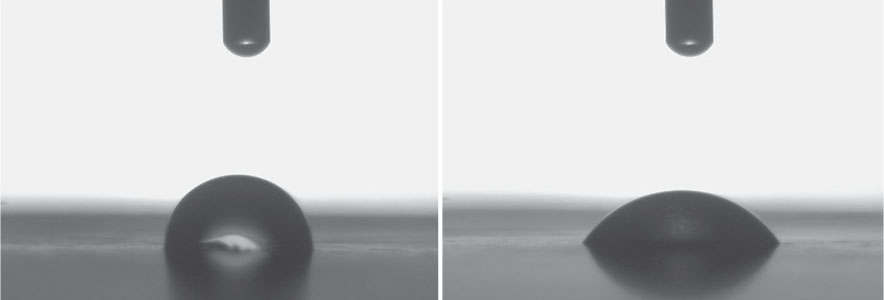
C2S paper features a fine pore structure within the glossy coating, setting up a capillary network that literally pulls liquid into the paper. On the other hand, the fibers on the backside of C1S label papers have larger pores than the coating, and they are treated with sizing agents that interrupt the capillary network to inhibit absorption, so the capillary forces are much less apparent than in C2S papers. This combination of a coating prone to fast capillary absorption and a fiber matrix with no resistance to water absorption can result in undesirable results during labeling. While the fiber matrix could be treated to reduce its tendency to absorb water, the reverse-side coating layer in C2S still would provide the fine pore structure that is responsible for faster absorption at the coating surface.
Both tests were performed using pure water to demonstrate behavior with water-based adhesives. However, these results could not be used to predict behavior of non-aqueous materials, such as hot-melt adhesives. From an adhesive management perspective, there may be situations in which a C2S paper may perform acceptably well with hot-melt adhesive. In these situations, there are a number of other factors to consider and a more in-depth assessment is required.
Consequential differences inherent to C1S and C2s papers
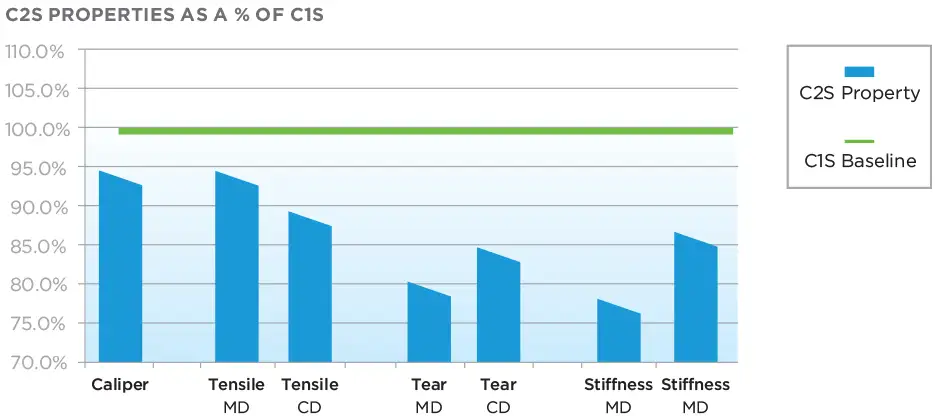
Fiber or coating? At equal basis weight, the weight of the coating on the reverse side of C2S paper is replaced with fiber in C1S paper. For typical label papers, there will be 15% to 30% more fiber in a C1S label paper when compared to the same weight C2S paper. The extra fiber in the C1S label paper contributes strength, caliper and stiffness that is not provided by the coating layer on the reverse side of C2S papers (see Figure 3). The improved physical properties found in C1S label paper translate into higher productivity on press through higher press speeds, fewer misfeeds and easier handling of the paper on both ends of the press.
Asymmetrical design: C1S label papers have a rougher surface on the back side (see Figure 4). Although it would seem that the smooth, “slippery” surfaces of C2S papers would provide a lower coefficient of friction and allow sheets or labels to feed more easily, we find that in practice the opposite is true. The rougher reverse side of C1S papers creates a smoothness differential between the print side and the reverse side, and that helps separate the labels when they are being fed into a high-speed press or a high-speed labeler. One theory on this behavior is that the smooth surfaces of C2S paper act like two sheets of glass that tend to stick together – because there is no pressure relief, a vacuum forms between them when they are pulled apart. On the other hand, C1S label papers do not make that level of intimate contact, so they are less prone to sheet separation issues during the labeling process.
Manufactured for specific end use
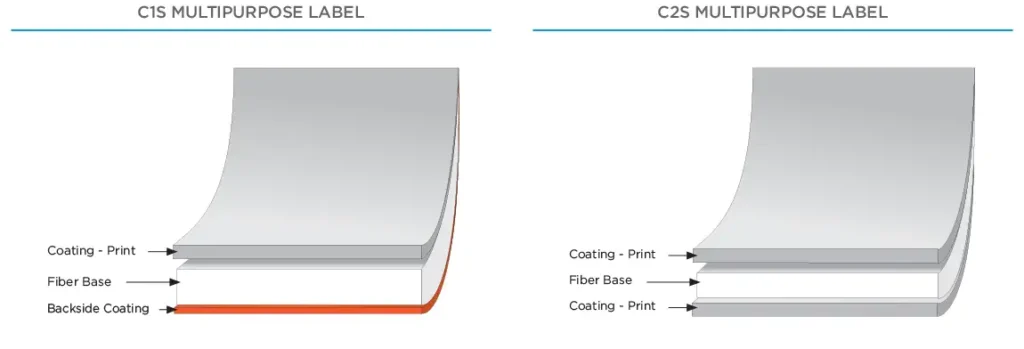
A final and major factor is that C1S label papers are designed and manufactured specifically for label printing and labeling markets, and great care is taken to focus on that intended end use. From procurement to final inspection, when C1S is being produced, all eyes are on the goal of producing a label that will run consistently at the printer and labeler. To accomplish this, raw-material changes are infrequent, and qualifications are held to a very high standard, because there is no way to thoroughly test every application and end use for the product.
Inspections during and after manufacturing are held to a high standard, knowing that the label printer and labeler are counting on the labels to run consistently and reliably on high-speed printing and labeling equipment.
In contrast, when C2S paper for commercial printing is being manufactured, the focus is on a different goal – to ensure that the product is suitable for two-side printing and binding into magazines and brochures. The standards set for C2S paper are not necessarily lower but are more reflective of the intended end-use. There are numerous tiers of C2S papers available, ranging from digital and inkjet papers to sheetfed or web offset, at differing levels of brightness, gloss, smoothness and moisture level. Each variation has its properties and varying quality expectations, so there is no “typical” C2S printing paper. We also are able to thoroughly evaluate and confirm suitability for these end uses, so raw material and equipment changes do occur more frequently in C2S papers to compete in these markets.
Conclusion
The advantages associated with increased fiber content and controlled water absorption provide compelling reasons for labels to be produced using C1S label paper. However, the overlooked reality that C1S label papers are produced specifically for the label markets is every bit as essential to consider when choosing a label stock. Just as a good mechanic or an accomplished chef selects the proper tools and materials to satisfy their customers, C1S label paper provides the label printer/converter with the right tools to fully and consistently satisfy their customers’ needs.
Pixelle Specialty Solutions (Spring Grove, PA) can be reached at 717-225-4711, email: customerservice@pixelle.com, www.pixelle.com.

